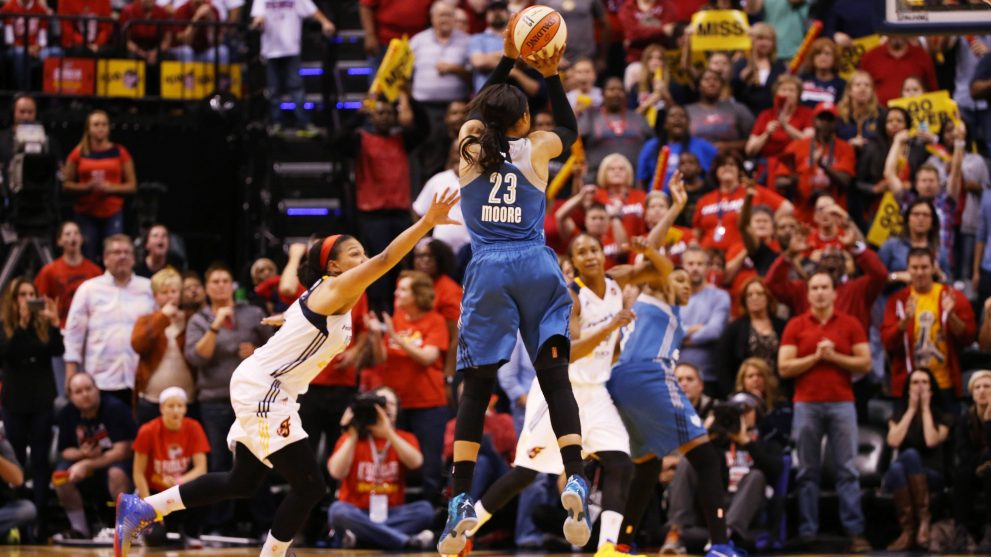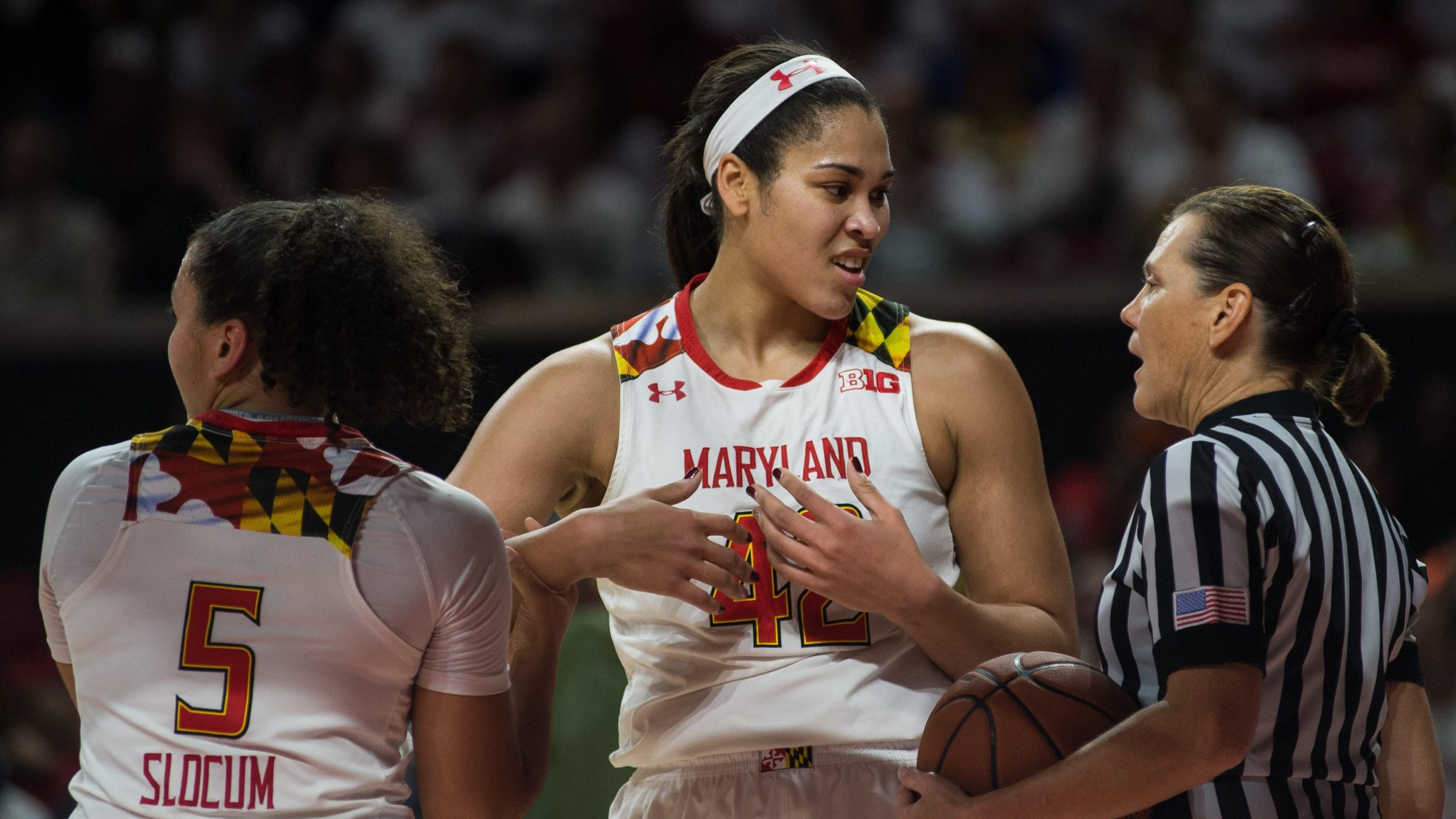Headed into the Commissioner’s Cup next week, the 2023 season is nearly three quarters of the way through. The 4 and 9 seeds are separated by only 4.5 games, leaving a significant amount for shuffling and wiggle room in the middle of the standings over the last month of the regular season.
2023 has been marked as a season of record-breaking. Triple-doubles have been in abundance. Diana Taurasi surpassed the 10,000 point mark for her career, the first player to do so in league history.
The Las Vegas Aces are on track to set the record for offensive efficiency in a season, and the New York Liberty have a shot to enter the top-ten all-time in that category if they keep up their post-All-Star Break play (They’d finish with the 17th-most efficient offense in W history at present according to Her Hoop Stats.)
Over the past few seasons, three-point shooting has become increasingly centralized to offensive output in the WNBA.
The Aces upped the standard with respect to volume and efficiency from deep during their title run last season, launching 26.4 triples per game while shooting 36.1% on them, second-best in the league. This current iteration of the Liberty is on pace to be the greatest shooting team of all-time when factoring in volume and accuracy, currently taking 29.5 per game (most of all time) and shooting 37.5% from beyond the arc.
This Aces squad is really one of the greatest, most cohesive assemblies of talent we've ever seen grace the basketball court
period
They're all about the process, getting better, and winning another title, but it's hard not to just smile at how absurd this team is right now
— Mark Schindler (@MG_Schindler) July 12, 2023
Since the inception of the league, 17 teams have taken 20 or more threes per game while hitting on 36% or more of those shots; three this season (Aces, Liberty, Sky) and over half of those teams qualified have come since 2020, which stands out considering trends over time.
Six players in 2023 are putting up some of the greatest volume three point scoring seasons we’ve ever seen in the league.
When accounting for usage (20% or higher), accuracy (36% or better), volume (5.5 attempts per game or more), and a large enough sample of games (15 or more) through Her Hoop Stats’ research tool, Jewell Loyd, Sabrina Ionescu, Rhyne Howard, Breanna Stewart, Kelsey Plum, and Kelsey Mitchell all surpass the criteria.
The most players to meet those marks over a single season simultaneously was four multiple times (2008, 2009, 2012), and 22 players in total have accomplished this feat, many multiple times (46 total individual qualifying seasons).
Is 2023 the greatest shooting season in league history?
There’s a strong case for it, but historical reference and input gives us even better context for understanding why these numbers are increasing, what stands out about the six players noted, and what this means for the game moving forward.
Pace (Average possessions by a team per game) has risen from the mid 70’s in the early 2010’s to the high 70’s in recent years, teetering on 80 this season (79.3). There have always been teams that played faster with more tempo, an emphasis on early offense; you are now in the minority if you aren’t baking that into your offense.
Katie Smith was perhaps the first player that staked her claim as a shooting great, on top of phenomenal all-around play.
Smith finds herself on the list four times, remarkable in and of itself, but all the more so considering she started her pro career before the WNBA was founded.
Again, another modern principle, but with some of the less modern spacing
The initial flare screen for Katie Smith, doesn't go.
Stars setup to deny. Triple staggers for Smith off ball, play out of the motion and her shooting gravity into the post, draw help, find opening pic.twitter.com/jqw8L1NV5R
— Mark Schindler (@MG_Schindler) August 9, 2023
You can oftentimes get the best idea of who someone is as a shooter in plays that they… don’t even shoot! This play exemplifies that, and is a blast to watch when appreciating that this was 15 years ago.
Flare screens, essentially a screen to set up a player drifting towards the opposite direction, are a modern staple. They’ve been a part of offenses for a long time, but would occur more for a spot up two rather than a three.
The Detroit teams Smith played on used her shooting gravity (ability to draw the defense with her off-ball threat) to set up motion in their offense and attack with quick ball movement and reading defenses to find gaps, a very modern concept. The spacing is different to be sure, but the ideology that showed through the kind of player Smith was stands out.
When Smith played for the Lynx, what I’d consider the prime of her career, they played with breathtaking pace, prioritized transition and early offense, and I’d argue it was the first time we saw a team in the W that played with an outside-the-three-point-line in mentality.
That shooting gravity mixed with Smith’s playmaking and vision was a staple of the Lynx.
Smith was an incredible pull-up threat. She could shoot off of movement. She was knockdown if left open and was expert at relocating to open up herself for cleaner looks. She even excelled as a screener into a shot motion.
Watch how she backscreens to open the cut, force the defense to pause momentarily, and then flows into a screen for herself before the open shot.
Stars and Liberty guard Becky Hammon (non-coincidentally now the Aces’ coach leading a record-breaking offense) embodied many of the same principles, particularly as a ball screen creator. She brought even more guile and creation as a true lead guard, but found herself on this list more than anyone but Diana Taurasi.
Hammon was a sensational pull-up shooter, part of what set her apart as a guard.
She had a solid first step, but her handle, creativity, and ability to play with pace and craftiness made her a top-flight point guard. Playing through those avenues is accentuated through the ability to force the defense to deny you, put extra pressure on screens you run, and in general spread the court further.
The volume and variety in her shooting was essential.
Taurasi is without question the greatest shooter in the league’s history. She’s much more than “just a shooter” but the jumper was paramount in her scoring arsenal, the key that unlocked the versatility in her scoring game.
She embodies much of the same ideas as all the players aforementioned, but when factoring in the size she has at 6 feet tall, along with an incredibly explosive first step in her early days and prime, there hasn’t been a player with her intersection of skill. The key takeaway is her movement and shooting mixed together.
Few have ever been as willing and able to pull-up early and often like Taurasi. Paul Westhead’s offense in 2006 was pivotal in empowering Taurasi to do what she does best; play fast, play without second thought, cut, read and react, and let it fly.
Watching games from the 2006 Mercury stands out, Taurasi highlighted as one of the first players to take early-clock, off-the-dribble threes in league history.
It’s worth noting, and I understand why at points, that there is a notion of an off-the-dribble three, particularly early in the clock, being a “bad shot.”
Part of what I find so enticing about backtracking, watching, and trying to soak in more of what context was like, how teams wanted to play, and trying to understand why they wanted to is that it further illustrates that a “good shot” is not the same in every system. It isn’t the same for every player. Part of what’s made Taurasi so special as a player both in retrospect and at present is that she’s a threat at any time from anywhere on the court.
Multiple players fit that billing now, but she feels like the first player in the W that was really able to consistently capitalize on that in the highest regards.
While others had done it before, Sugar Rodgers took lateral creation as a shooter to the next level in the mid-2010’s. By this time, she didn’t have a monster first step and wasn’t what you might consider conventionally athletic. However, she was one of the better secondary creators in the league through how she was deployed by the Liberty.
New York ran a multitude of hand-offs and pistol action to get her side to side opportunities, where she excelled, capable of using her handle and footwork to create East/West space and in turn get to the middle of the floor if the defense overplayed.
Looking at some of the first wing shooters, Shameka Christon and Nicole Powell, that notion of intersection of size and skill is imperative. Both moved well without the ball and could shoot off of movement or out of actions, a step up from standstill shots.
Katie Douglas took those principles even further. Pairing up with Tamika Catchings in Indiana, the Fever built their offense around a forward tandem that excelled playing outside in, both players adding their names to this list throughout their careers. Catchings could shoot, post up, drive, isolate; she could do it all.
Douglas was extremely versatile as well, but largely based out of the way she could move and shoot at her size.
She could initiate offense out of ball screens, but what I find most striking is what she was able to do and how she was utilized without the ball.
Douglas had to have been near the top of the league in distance travelled per game when factoring in how much time she spent running off screens, reading how her defender was guarding her, and jutting into open space. She was adept at quick decisions and relocation, essential considering she wasn’t dominating out of her first step or downhill craft. She made space out of space that wasn’t there, in a sense, pitching the ball off and then playing off of how the defense did or didn’t react.
Maya Moore took everything a step further.
It’s not hyperbole to say Moore is the best wing creator that’s ever played the game and perhaps the greatest player, period. Her jumper and the versatility she had within it was such a huge reason as to why.
What do I mean by versatility?
Think of it almost like a spiderweb or that skill tree from Skyrim. Catch-and-shoot spot-up threes are the base, the very core of the thing we’re looking at. Going to the left, you have pull-up shooting and all variants of off-the-dribble shooting; can you hit off a stepback? Can you sidestep into an open J? How far laterally can you open yourself up with a dribble move? Going to the right, movement shooting; what’s your balance like? Can you replicate your shot base off multiple actions? Do you have the footwork to come off of screens and get shots off quickly?
Further on down the line, there’s a clutch factor. The ability to hit the most absurd shots IS a skill, even if unquantifiable.
Maya, much in the same vein as Taurasi, had an unreal knack for timing, one of the most important aspects of shooting and what I might consider the biggest difference in the past five years. As soon as there was a gap in the defense and an opening to shoot, it was going up cleanly.
Maya was and is the pinnacle of an offensive skillset outside of the post.
Every current player doesn’t bring it in the same package as her, but you can find shades of it within the way they play, embodying some of the great shooters of the past.
It’s easy to see shades of Hammon and Katie Smith in Sabrina Ionescu, currently on the biggest shooting heater in the league, shooting 43.5% from deep on 9.2 attempts per game since the All-Star Break. She wins with pace, by using screens as a buffer, and with a hair-quick trigger. The same can be said of Kelsey Plum, one of the best screeners in the league, which matters greatly when you consider her shooting threat; the Aces love to use her as a back screener or cross screener for interior actions to create a mesmerizing push pull for defenses to juggle.
Jewell Loyd is adept at screen usage, but in a different way than Ionescu, with that lateral creation aforementioned and her handle paramount in freeing up vital inches of space to get her shot off.
That’s part of what’s so interesting in basketball and in shooting as well; you can look at stats, at numbers, trends and go “hey, they play really similar” and not be wrong at all, but also lose sight of how different it is to run off a screen and can a jumper without a dribble, vs. coming off a screen, sizing up, probing and escaping into a backfoot banker.
There’s the same result, but the process could not be more different, and that’s kinda beautiful when you really think about it.
You can see the downhill explosiveness and start/stop ability in Kelsey Mitchell that Ivory Latta brought in the mid-2010’s. You can see some of the shades of Douglas and Moore in Rhyne Howard in how she moves without the ball, reads defenses, and hits some unconscionable jumpers with respect to range and difficulty.
Breanna Stewart has that same high release and head-scratching ability to swish these contorted absurdly contested looks like Moore.
No two games are the same, but it pays dividends to understand the similarities, appreciate them, and take heed of why they matter.
What stands out now amongst this core group of stars establishing themselves through their shooting prowess is the quickness. Releases are so fast, so consistent, and easily replicable. Decisions are made faster, something that coaching continues to emphasize more and more.
When a defense goes under on a screen or there’s a gap in screen coverage, those advantages are expanded upon even more consistently and quickly now. Teams work to specifically attack pockets on ball screen coverages for the best shooters (watch Atlanta and New York specifically).
Pull-up shooting is becoming increasingly more effective and relied upon. Part of what made some of those earlier shooters so impressive was that they were so far from the norm in that regard.
So are we amidst the greatest shooting season of league history? During the current environment, context, and parameters of the game, yes.
As those continue to shift and alter with development within the league, players entering with different skillsets grown through watching current modern play, and continued advancements in the game strategically, it feels as though we might be having this conversation repeatedly moving forward. I’m here for it.







